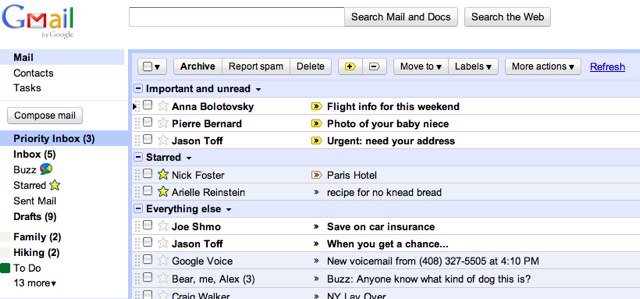What does Gmail's priority inbox mean for email marketers?
Gmail’s recently announced Priority Inbox feature uses an algorithm to automatically sort busy inboxes into ‘Priority’, ‘Starred’ and ‘Everything Else’. Criteria for sorting into the priority inbox include keywords, people the user emails most and general user behavior (e.g. previous open rates). Rules can also be set up by the user to automatically filter certain emails into the priority folder, and the algorithm is adaptive, so it will learn more about the user’s behavior and preferences with time.

What does it mean for email marketing?
There are two main things for email marketers to consider: first, how do you get marketing emails into the priority inbox? and secondly, do you want to be in the priority inbox in the first place?
The key to getting into the priority inbox is relevance. The user is now actively teaching filters what they want to read, so every mailing should be as useful and engaging as possible. This means segregating your lists, following design and HTML best practice and cutting out irrelevant ‘blanket blasts’ to everyone. It might even mean mailing people less sometimes.
Lets look at some of the filter criteria:
Keywords
A good way to get relevant keywords into an email is to include lots of html web text and avoid trapping your text as all-image builds. It also means you should pay attention to your copy as its now bring scrutinized more than ever. I’m sure a side effect of this will be to add ‘important’ to every email. That won’t get you very far. (see also keyword stuffing on the web)
Sender reputation
The chances are the user won’t send many emails to your sending address, but having them add it to their address book will help mark it out as a trusted source. Perhaps you could get them to use the send address for feedback – it means investing in a response management team to handle replys and not using [email protected]. Your ESP should be able to help with this.
User Behaviour
Admittedly this is a bit of a catch all heading at the moment, but really it means you should aim for higher open rates by optimising subject lines, and encourage lots of repeat openings by having a consistent sending schedule and always providing compelling content.
It’s worth also considering how your audience will use the priority inbox and how this will affect the content and tone of voice of your campaigns. For example, if your campaign’s aim is to communicate one message quickly and drive clicks online, it should be optimized so the user can easily scan and act upon it. If you find your users prefer to take longer to properly read your emails (for example it may contain lots of editorial content), then you may wish to add a “star this email to read it later” call to action to your preheader. (Having a history of being ‘starred’ may also be a factor for getting into the Priority inbox in the first place)
Bear in mind that whilst the user will check the priority email first, in this folder they will be scanning things quickly and looking for things to act upon. The users mind state once they come to read the regular inbox afterwards may be easier to engage with for some marketers.
So really, preparing for Gmail’s priority inbox is actually an exercise in being a better email marketer. Smarter inboxes like this are becoming more common, and most of the major webmail players have made noises about this recently, so it’s something that’s not going away. Granted, it does raise the bar in terms of relevance and optimisation, but the only real losers here are ‘batch and blast’ marketers sending one message to everyone they can find in the hope that it’ll convert someone – and getting those guys out of the picture is good for everyone, right?
Find out more about Gmail Priority inbox on Mashable, Guardian’s Tech Blog and on Gmail’s Blog.
Elliot Ross is a Senior Creative Designer at e-Dialog London. He writes an email design best practice blog and you can find him on Twitter.
Pingback: Priority inboxes, intelligent inboxes, quality bars and you – Constant Responses()
Pingback: E-mail Precisely()
Pingback: Google’s Priority Inbox | Elliot Ross | iamelliot.com()
Pingback: Facebook for Marketers | MailChimp Email Marketing Blog()